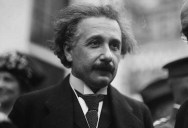How Einstein’s Brain Ended Up in A Series of Bizarre Places
For all the fame Albert Einstein garnered while alive, he became an even bigger curiosity after death. So much so that pieces of the legendary scientist’s brain were stored for decades in some bizarre locations.

Photo Source: Library of Congress
Before his death in 1955, Albert Einstein told his biographer, “I want to be cremated so people don’t come worship at my bones.” Per his wishes, Einstein’s ashes were spread at an unknown site. Imagine his family’s surprise and outrage when they discovered that, during his autopsy, Dr. Thomas Harvey with the University of Pennsylvania had removed and kept Einstein’s brain.
In fact, he kept most of the brain in a jar for 45 years!
Harvey was eventually granted permission to study Einstein’s brain and find out what made him so brilliant. However, Harvey never published any findings. Instead, Harvey measured, photographed, weighted, and commissioned paintings of the brain but never found anything significantly different between Einstein’s and the average brain.
Harvey then mailed four samples in a Kraft Miracle Whip mayonnaise jar to neuro-anatomist Marian Diamond from the University of California, Berkley. In 1985, Diamond reported a higher-than-average percentage of tightly packed glial cells in the part of Einstein’s brain thought to play a role in complex thinking. Trying to study a dead brain is much more difficult than analyzing a live one.
When asked why he kept Einstein’s brain in the first place, Dr. Harvey simply answered, “I didn’t know anyone else wanted to take it.”

Sign up to get our BEST stories of the week straight to your inbox.




